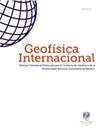Identificación de las fuentes de nitratos mediante métodos hidrogeoquímicos e isotópicos en el agua subterránea del Bajío Guanajuatense
IF 0.7
4区 地球科学
Q4 GEOCHEMISTRY & GEOPHYSICS
引用次数: 5
Abstract
espanolLa subprovincia del Bajio Guanajuatense, ubicado en el Centro de Mexico es una de las zonas agricolas mas importantes del pais, lo cual ha provocado el uso de grandes volumenes de agua. El panorama actual de Guanajuato indica un incremento, en mas del triple, del uso del agua subterranea respecto a la extraida hace 30 anos, usada para maximizar el rendimiento de cultivos, asi como una aplicacion desmedida de fertilizantes nitrogenados. Este contexto se torna mas grave dado que en la zona de estudio existen problemas de sobreexplotacion, abatimiento del nivel estatico, y presencia de fallas y fracturas, y aunado a ello contaminacion en distintos niveles de profundidad del acuifero por compuestos nitrogenados. El objetivo de este trabajo consistio en evaluar la presencia de compuestos de nitrogeno en los distintos flujos del acuifero, identificar isotopica e hidrogeoquimicamente las fuentes, sus transformaciones y los procesos relacionados con el elevado contenido de NO3 - en el agua subterranea. Con base en los resultados obtenidos de NO3 - , elementos quimicos mayores, menores, traza e isotopos, se han identificado dos fuentes de contaminacion; una relacionada con la agricultura y la segunda con el tratamiento de agua residual. Esto ha ocasionado que el contenido de NO3 - supere los valores permitidos por la NOM-127, de acuerdo a los datos de muestreo del 2017 y 2019, no solo en el acuifero somero tambien el profundo. Se llevaron a cabo dos campanas de muestreo de agua subterranea en 32 pozos urbanos y agricolas de los municipios de Vill y JR en Guanajuato, en temporada de lluvias y de estiaje, siguiendo metodos nacionales e internacionales. Se determinaron elementos mayores, menores y algunos elementos traza, asi como isotopos estables. El origen de los elevados contenidos de NO3 - es antropogenico; los valores mas elevados se cuantificaron en epoca de estiaje. Los nitratos migran mas facilmente a traves de fallas y fracturas profundas, principalmente en la zona centro-sur del area de estudio hacia el acuifero medio y posiblemente al profundo, este proceso es relevante ya que la zona es reconocida como un medio impermeable debido a la presencia de extensas capas de arcillas. Una planta de tratamiento de agua residual es un foco de contaminacion, la aplicacion de fertilizantes seria el otro posible foco de contaminacion. La transformacion de los compuestos nitrogenados pudieran afectar el comportamiento isotopico del δ18O, aunque no se descarta que podria deberse a procesos de evaporacion e infiltracion de agua somera. Esta informacion debe ser considerada ya que la presencia de nitratos en el medio pudiera poner en riesgo la salud de la poblacion que se abastece del mismo sistema acuifero donde se desarrollan estas actividades. EnglishThe sub-province Bajio Guanajuatense is located in Central Mexico, is one of the most important agricultural areas in Mexico, where are used large volumes of water. The current panorama of Guanajuato shows an increase of more than three times in the use of groundwater, compared to extraction 30 years ago; this water is used to maximize crop yields; another problem that has increased is the excessive use of nitrogen fertilizers in all the area. This context becomes more serious considering that in the study area, occurs problems of overexploitation, depletion of the piezometric level, presence of deep faults and fractures, coupled with contamination at different levels of the aquifer by nitrogen compounds. The objective of this work is to evaluate the presence of nitrogen compounds at different depths of the aquifer, in addition, to identifying isotopic and hydrogeochemical sources, their transformations and the processes related to the high NO3 - content in groundwater. Based on the results obtained from the concentration of NO3 - , major, minor chemical elements, trace and isotopes, two sources of pollution have been identified; one related to agriculture and the second to wastewater treatment, This has caused that NO3 - content exceed the values allowed by NOM-127, according to the sampling data of 2017 and 2019, not only the shallow aquifer is polluted, also the deep. Two groundwater sampling campaigns were carried out in 32 urban and agricultural wells of the municipalities of Vill and JR in Guanajuato, in rainy and dry season, following national and international methods. Major, minor and some trace elements were determined, as well as stable isotopes. The origin of the high content of NO3 - is anthropogenic; the highest values were quantified during the dry season. Nitrates migrate more easily through faults and deep fractures, mainly in the centralsouth zone of the study area to the middle aquifer and possibly to the deep one, this process is relevant since the area is recognized as an impermeable medium due to the presence of large layers of clays. A wastewater treatment plant is a source of contamination, the application of fertilizers would be the other possible source of contamination. The transformation of nitrogen compounds could affect the isotopic behavior of δ18O, although it is not ruled out that it could be due to evaporation processes and infiltration of shallow water. This information should be considered since the presence of nitrates in the environment represents a risk to the health of the population that is supplied by the same aquifer system where these activities take place.利用水文地球化学和同位素方法鉴定瓜纳华托巴吉奥地下水中的硝酸盐来源
位于墨西哥中部的巴吉奥瓜纳华滕斯省是该国最重要的农业区之一,这导致了大量的水的使用。瓜纳华托目前的情况表明,地下水的使用比30年前的提取增加了三倍多,提取用于最大限度地提高作物产量,以及过度施用氮肥。在研究区域,由于过度开采、静水位下降、断层和裂缝的存在,以及含水层不同深度的氮化合物污染,这种情况变得更加严重。这项工作的目的是评估含水层不同流动中氮化合物的存在,从同位素和水文地球化学上确定与地下水中NO3 -含量高有关的来源、它们的转化和过程。根据NO3 -、主要化学元素、次要化学元素、微量元素和同位素的结果,确定了两个污染源;一个与农业有关,另一个与废水处理有关。根据2017年和2019年的采样数据,这导致NO3 -的含量超过了NOM-127允许的值,不仅在浅层含水层,而且在深层含水层。在瓜纳华托的Vill和JR市的32口城市和农业井中,按照国家和国际方法,在雨季和旱季进行了两次地下水取样。测定了主要元素、次要元素和一些微量元素以及稳定同位素。NO3 -含量高的原因是人为的;在旱季和雨季分别采集了2个和3个样本。这些硝酸盐迁徙更容易通过断层和断裂区深,主要是在研究地区发往acuifero中期和深入,这个过程可能是重要的,因为地区是公认的雨衣由于广泛存在的一种手段粘土层。废水处理厂是一个污染源,化肥的施用是另一个可能的污染源。氮化合物的转化可能会影响δ18O的同位素行为,但不能排除这可能是由于蒸发和浅水渗透过程。这些信息必须考虑到环境中硝酸盐的存在可能危及从进行这些活动的同一含水层系统供应的人口的健康。Bajio Guanajuatense省位于墨西哥中部,是墨西哥最重要的农业地区之一,那里使用了大量的水。瓜纳华托目前的情况显示,与30年前的采掘相比,地下水的使用增加了三倍以上;这些水被用来最大限度地提高作物产量;另一个日益严重的问题是整个地区过度使用氮肥。这种情况更加严重,因为在研究领域中出现了过度开采、压电水平耗竭、存在深度断层和裂缝以及含水层不同水平受到氮化合物污染等问题。这项工作的目的是评估含水层不同深度氮化合物的存在情况,并确定同位素和水文地球化学来源、它们的转化以及与地下水中高NO3含量有关的过程。根据NO3 -、主要化学元素、微量元素和同位素浓度的结果,确定了两种污染源;根据2017年和2019年的采样数据,NO3 -内容超过了NOM-127允许的值,不仅浅层含水层受到污染,深层含水层也受到污染。在雨季和旱季,按照国家和国际方法,在瓜纳华托维尔市和小市的32个城市和农业井进行了两次地下水取样运动。= =地理= =根据美国人口普查局的数据,该县总面积为,其中土地和(1.)水。NO3 -高含量的起源是人为的;= =地理= =根据美国人口普查局的数据,该县总面积为,其中土地和(1.1%)水。硝酸盐更容易通过断层和深裂缝迁移,主要在研究区中南部地区迁移到中含水层,并可能迁移到深含水层,这一过程是相关的,因为该地区被认为是不透水的介质,因为存在大量的粘土层。
本文章由计算机程序翻译,如有差异,请以英文原文为准。
求助全文
约1分钟内获得全文
求助全文
来源期刊

Geofisica Internacional
地学-地球化学与地球物理
CiteScore
1.00
自引率
0.00%
发文量
23
审稿时长
>12 weeks
期刊介绍:
Geofísica internacional is a quarterly scientific journal that publishes original papers that contain topics that are interesting for the geophysical community. The journal publishes research and review articles, brief notes and reviews books about seismology, volcanology, spacial sciences, hydrology and exploration, paleomagnetism and tectonic, and physical oceanography.
 求助内容:
求助内容: 应助结果提醒方式:
应助结果提醒方式:


